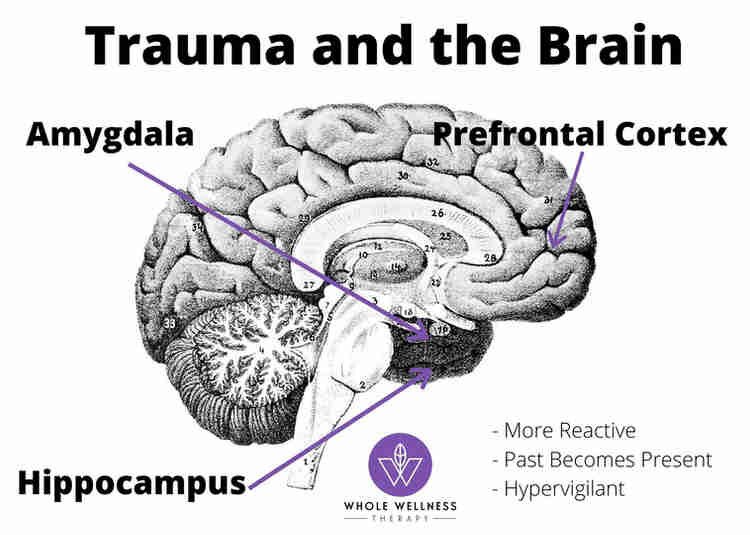Anxiety vs Trauma Response (March 2025 Newsletter)
We often hear about anxiety and trauma responses, but what’s the difference? More importantly, how can we recognize and regulate these experiences in our daily lives? This week, we’re diving into the distinctions between anxiety and trauma, along with powerful tools to support emotional resilience.
Anxiety vs. Trauma Responses: What’s the Difference?
Anxiety is a response to perceived future threats, leading to excessive worry, restlessness, and physical symptoms like rapid heartbeat. It’s often about uncertainty and what could happen.
Trauma responses, on the other hand, stem from past distressing events. These reactions can include flashbacks, dissociation, hypervigilance, and emotional numbness, as the body reacts as if the past danger is happening now.
Recognizing these differences helps us approach healing with the right tools. Below are a few techniques to regulate distress and bring the body back into balance.
The Amygdala regulates emotions, the hippocampus is your memory center, and the prefrontal cortex is your decision-making center. Each of these areas of the brain work together with your sympathetic nervous system (fight or flight response) by evaluating your current situation and comparing it to your past experiences when you are experiencing a trauma response.
The Distress Thermometer: A Tool for Self-Awareness
Understanding your distress level is key to managing emotions before they escalate.
📝 How to Use It:
Rate your distress from 0 (completely calm) to 10 (extreme distress/meltdown).
Ask yourself: What is my body’s response at this level? Do you feel tension, racing thoughts, or numbness?
Identify your triggers and use the thermometer to recognize when self-regulation techniques are needed.
Talk Time: Next time you experience a meltdown or heightened distress, reflect on where it fell on the thermometer. Naming emotions is the first step to reclaiming control.
Breathwork for Regulation
One of the simplest ways to reset the nervous system is through breathwork. Try diaphragmatic breathing to activate your body’s relaxation response:
Inhale deeply through your nose for 4 seconds, expanding your belly.
Hold for 4 seconds.
Exhale slowly through your mouth for 6-8 seconds.
Repeat 5-10 times.
This technique calms the sympathetic nervous system, helping to reduce anxiety and bring you back to the present.
Learn the Diaphragmatic Breathing Technique
5-4-3-2-1 Grounding Technique
When anxiety or trauma responses take over, grounding brings you back to the present moment. The 5-4-3-2-1 method, a DBT grounding technique, engages your senses:
5 things you can see
4 things you can touch
3 things you can hear
2 things you can smell
1 thing you can taste
Try this next time you feel overwhelmed to reconnect with your surroundings.
Resetting a Trauma Response: Polyvagal Techniques
When trauma triggers a fight, flight, freeze, or fawn response, our nervous system needs support to regulate.
✅ What Happens During a Trauma Response?
Heart rate increases, muscles tense, and breath becomes shallow.
The body shuts down, making you feel disconnected or numb.
Hypervigilance kicks in, making everyday situations feel unsafe.
✅ How to Reset the Nervous System:
Vagus Nerve Activation: Humming, singing, or gargling water stimulates the vagus nerve, helping to regulate emotions.
Cold Water Exposure: Splash cold water on your face or hold an ice pack on your chest to signal safety to the nervous system.
Rhythmic Movement: Walking, rocking, or slow-paced dancing engages the body in a way that promotes calm.
Connection: Safe social interaction, eye contact, or even petting an animal can bring regulation.
Vagus Nerve Reset To Release Trauma Stored In The Body (Polyvagal Exercises)
Qigong Shaking Exercise
During a Qigong shaking exercise session, you typically stand with feet shoulder-width apart, relax the body, and then begin to shake various parts of their body, such as the arms, legs, torso, and head, one at a time or all together simultaneously.
Final Thoughts
Healing anxiety and trauma responses is not about suppressing emotions but learning to recognize, name, and regulate them. By integrating these tools, we create a foundation for emotional resilience and self-compassion.



